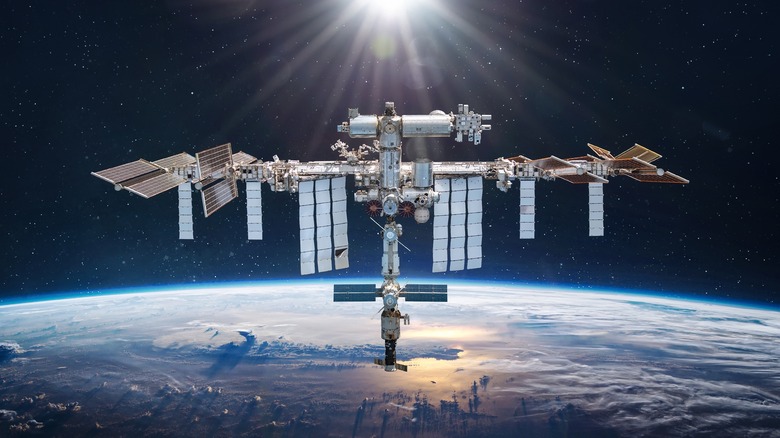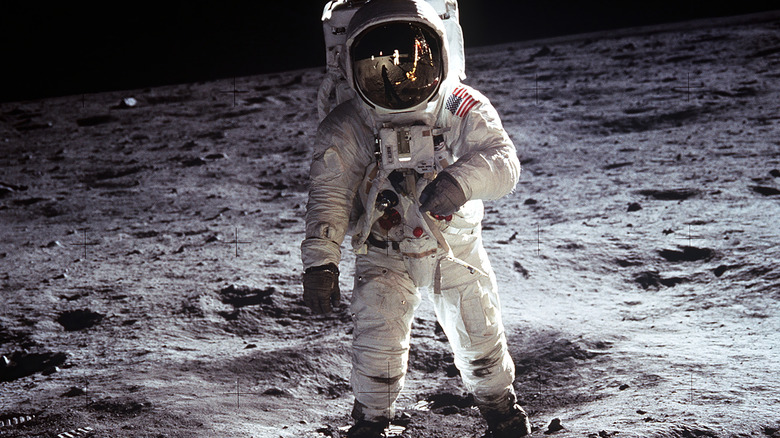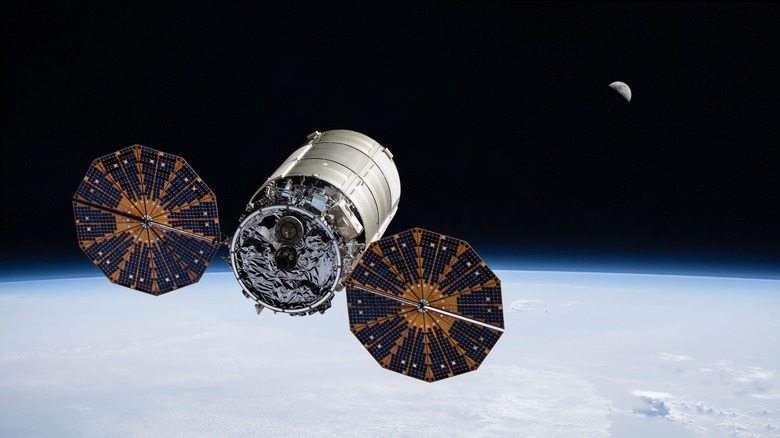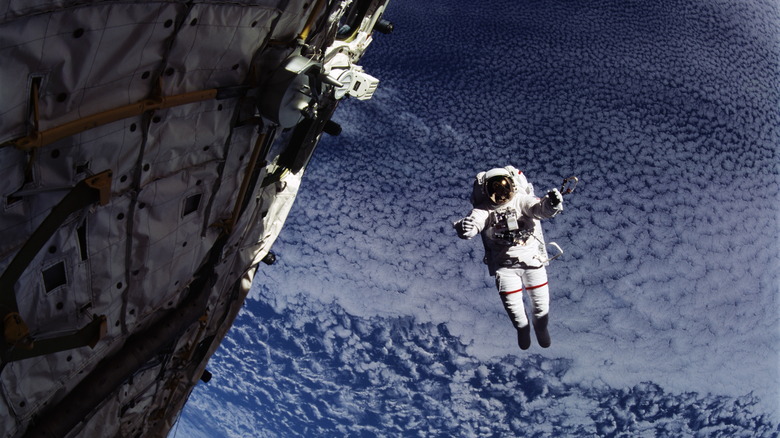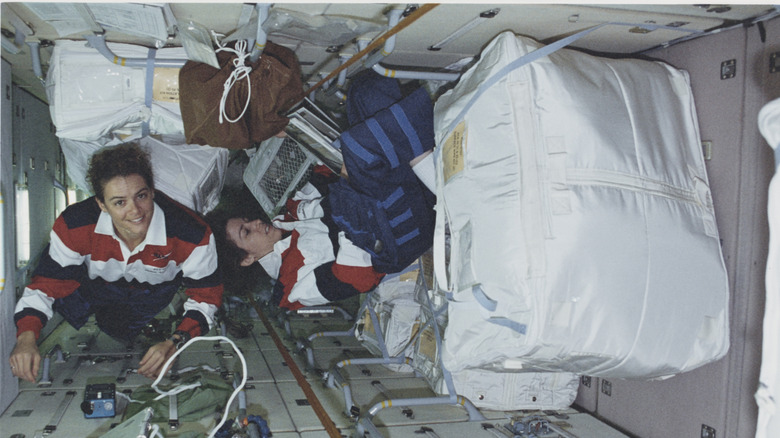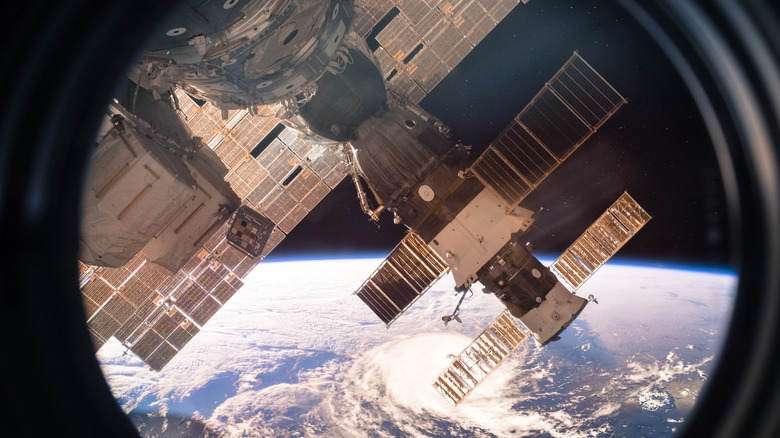How Solid Waste Management Works On The International Space Station
The International Space Station is undoubtedly one of the greatest feats of engineering in human history. Launched in the year 1998 by a consortium of space agencies from the United States, Europe, and Japan, the ISS was largely assembled in space, a remarkable feat in and of itself. Even more impressive is the fact that the station has been continuously upgraded over the decades since, allowing it to outlive every other space station program in history. The ISS is used for many kinds of experiments, which have in turn transformed our knowledge of astronomy and technology. It's a testament to the incredible potential of human ingenuity, but that doesn't mean it's perfect.
There are a lot of challenges associated with operating the ISS, and we're still learning how to tackle them. Careful attention must be paid to things that would otherwise be routine on Earth, like what astronauts eat. That's only the beginning, as everything astronauts eat, and many of the items they use on a daily basis, are destined to become waste. With no landfills or recycling centers to handle all the mess, astronauts on the space station are left with essentially one option: ejecting their garbage into space. Yes, that's really how they do it, at least for now, but NASA and the other agencies involved with the ISS are searching for new and better solutions.
A brief history of space trash
When it comes to the matter of waste disposal in space, we've always had to learn as we go. During early NASA missions, such as Project Mercury, which put the first American astronaut in space in 1961, waste wasn't really an issue because the flights were so short. Of the six Mercury missions, only one lasted longer than a day. During these flights, astronauts used bags to collect their waste, including urine and feces, which they could then dispose of upon their return to Earth. It was only once the Apollo Moon landing program and subsequent long-duration space missions got underway that work began on long-term waste management solutions for astronauts.
When Neil Armstrong became the first human to set foot on the Moon, he also dropped off a bag of trash, which included old food wrappers and containers of urine and feces. Subsequent Moon missions took the same approach, and there are now almost 100 bags of trash just sitting on the Moon. NASA has announced its intention to recover the trash at some point, though concrete plans are yet to be implemented. Meanwhile, the space agency's shift in focus from the Moon to the International Space Station prompted an even bigger challenge. The ISS is built to sustain a crew of seven, with as much space as a large house, and there isn't a convenient place to just 'drop off' your garbage.
How waste disposal currently works on the ISS
The first step of waste removal aboard the International Space Station is no different than on Earth: toss your garbage in a trash bag. However, the trash bags used on the ISS are a bit different from the ones in your home. The crew divides dry waste from wet waste, placing each in separate bags. Storing these trash bags presents two major issues, the first being a matter of space; with the limited area inside the ISS, every inch is precious. To help compact the trash as much as possible, the crew will wrap duct tape around them to form tight bundles colloquially known as trash footballs, but this rudimentary solution still takes up a lot of room. The second major issue is that some trash, particularly wet waste, can present a biohazard to the ISS crew. Therefore, it is in everyone's best interest to get all that trash off the ISS as quickly as possible.
To remove waste, the ISS has its own version of garbage trucks. Every few months, small, unmanned craft are sent up to the ISS to deliver the supplies astronauts need to survive in space. After dropping off its shipment, the craft gets loaded up with garbage bags and sent back to Earth. However, you don't need to worry about astronaut garbage falling out of the sky because the supply craft incinerate when they reenter Earth's atmosphere. It might come as a shock to learn that the ISS crew disposes of trash by simply burning it up in the atmosphere, but sometimes they don't even use special craft for it: They just toss it into space.
Some trash is offloaded during space walks
With the rarity of supply missions and the highly limited space aboard the International Space Station, astronauts don't always use unmanned craft for their trash disposal needs. There have been numerous instances in which astronauts have offloaded garbage while conducting spacewalks. A spacewalk is any instance in which an astronaut puts on their spacesuit and steps outside of the ISS. Spacewalks are often done to make repairs on the station, and to upgrade it with new equipment. Spacewalks also allow astronauts to conduct experiments in space, accomplishing things that could never be done in a terrestrial lab. Occasionally, they also serve as trash runs.
When astronauts throw trash out during spacewalks, it's often pieces of old equipment that have exhausted their use or become outdated. For instance, in 2007, the ISS crew tossed out a 1,400-pound tank of ammonia coolant that they had been keeping as a backup for the station's main cooling system. Once the need for the backup was eliminated, the size of the tank and the hazard presented by ammonia made disposing of the tank the logical choice. In other cases, trash ends up in space by accident, as occurred in 2017, when an ISS crew member lost hold of a debris shield from the station's exterior.
The limitations of space waste disposal
If burning trash in Earth's atmosphere sounds like a risky idea to you, you're right to be suspicious. Scientists have warned that space junk poses a threat to the climate, but the trash itself isn't the biggest problem. The primary concern is with the supply craft that carry the offloaded garbage. These craft, along with numerous satellites that have been launched into orbit over the years, contain large amounts of aluminum, which can deplete the ozone layer. Even the rockets used to launch those spacecraft pollute the atmosphere with aluminum in their fuel. Furthermore, if enough aluminum builds up in the atmosphere, it could also affect the way the sun's rays hit the planet, potentially altering global light and temperatures.
Sometimes, the trash from the ISS fails to completely incinerate in the atmosphere, and that causes more problems. In 2021, astronauts used a robotic arm on the ISS to toss out a 5,800-pound pallet of dead batteries, the largest piece of trash ever discarded from the station. The junk orbited Earth for three years, but in March of 2024, it finally reentered the atmosphere. Part of it appeared to burn up, but a roughly 2-pound piece of equipment used to secure the batteries to the pallet ended up surviving reentry and subsequently crashed into a home in Florida. Although there were no injuries, it is an ominous look at the dangers of the ISS's current waste disposal systems.
Solutions for the future
NASA and the other space agencies involved with the International Space Station have been working to develop better waste disposal systems. In 2023, NASA contracted the Sierra Space company to build a new trash compaction system for the ISS that could greatly increase the amount of trash the station can store at a time. Furthermore, the system will be able to remove water from wet waste bags, making them less risky to deal with. The system is scheduled to be tested on the ISS in 2026.
Another exciting development in ISS trash disposal is the invention of a new trash ejection system. First used in 2022, the system allows astronauts to place their bags of trash directly into an airlock that will eject trash from the station back to Earth without the use of a supply vehicle. This would make it much easier to get rid of trash and free up space on the station.
Most importantly, NASA has been working to develop better recycling systems aboard the space station. Impressive technologies are already in place to turn waste into resources, such as a water recycling system that turns the astronauts' sweat and urine into drinking water that's even purer than regular tap water. Even more promising is a newly proposed system called the Orbital Syngas/Commodity Augmentation Reactor (OSCAR), which aims to turn garbage like food wrappers into fuel.
